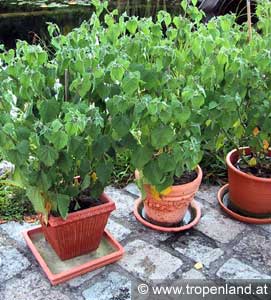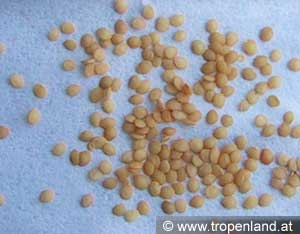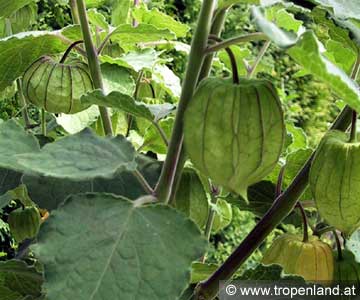regions:
In large part it is now grown in South Africa. In many other tropical and subtropical countries, it is cultivated. The original homeland lies in the Andes of South America.
| | |
Growth:
There is a 1 to 1.5 m high shrub to multi-year is. The appearance shows no similarity to the European gooseberry. The shrub has no spines. The leaves are alternate, slightly hairy, heart-shaped pointed, 5 to 14cm long and 10cm wide. The flowers appear in the leaf axils and on the shoot tips. They are yellow with small black spots near the stamens and can be fertilized with its own pollen.
 In summer, the Cape gooseberry brings Mediterranean flair to the terrace. |  flower and bud on hairy stems. |
location:
| summer | On a sunny spot as possible on the terrace or in the garden it is the Cape gooseberry best. Watch for wind protection, as the herbaceous branches are bent slightly. |
| Winter | the Cape gooseberry is cultivated perennial, it does in winter, a bright but cool location. In no case should the plant grow in winter, as the shoots are very thin and then have to be cut away in the spring anyway. Usually, the Cape gooseberry but cultivated for only one year and therefore not overwinters. |
| | |
cultivation / propagation:
seeds are available in some garden stores and hardware stores. Sows the seeds already in February, one can already blooms in early summer and thus expect fruit. The fruits are always available in supermarkets. You cut the fruit and picks out the small white seeds from the flesh. The seeds are sown on standard soil, but not covered with soil. Instead, cast light and A film put over the planter. This ensures even moisture and prevents drying. You can use as an alternative, a small mini-greenhouse. After forming the 4.Blattes the plants are separated. Usually you get a lot more plants than you really need. The plants can now be kept in the pot. If you want to keep the plant for only one year, they may be exposed to the end of May in the garden.
 seeds from the fruit are perfect for propagation. | |
substrate:
No special requirements. Rich, loose soil is sufficient.
| | |
casting:
The large herbaceous leaves evaporate more water, which must be continually replaced, so the water demand in summer is relatively high. The drying of the root ball does not tolerate the Cape gooseberry. Even in winter the humidity must have a light ball.
 careful not to late to start growing, otherwise the fruits ripen, in the wintertime, anymore. | |
fertilizing:
fertilize in the growing season once a week. From the end of August, the fertilizer will be set.
| | |
fruiting / harvesting:
develop in sunny location in well with us reliably good fruit. The fruits are 1.5 to 2cm in size. They sparkle and are yellow to orange. They are of a delicate shell, where is it is the dried calyx, surrounded. This case is, as long as they do not damaged, inflated like a balloon. The orange, sweet-sour pulp contains small white seeds that are edible.
 on fruit with broken envelope. | |
fruit use:
The fruits are eaten fresh or used in fruit salads, cocktails, jams, sauces and ice cream. The fruits are rich in vitamin A, phosphorus, and pectin.
| | |
warning:
Since the genus includes many species, some are toxic. Be careful not to catch the wrong one! For example P. alkehengi is with us as an ornamental plant to be widespread and toxic. If you buy seeds in stores or remove seeds from supermarket fruit, this risk is almost nonexistent.
| | |
genus Info:
The genus includes over 100 species. There are only a few crops than in use.
| | |
| | |
Text: Dominik Again

0 comments:
Post a Comment